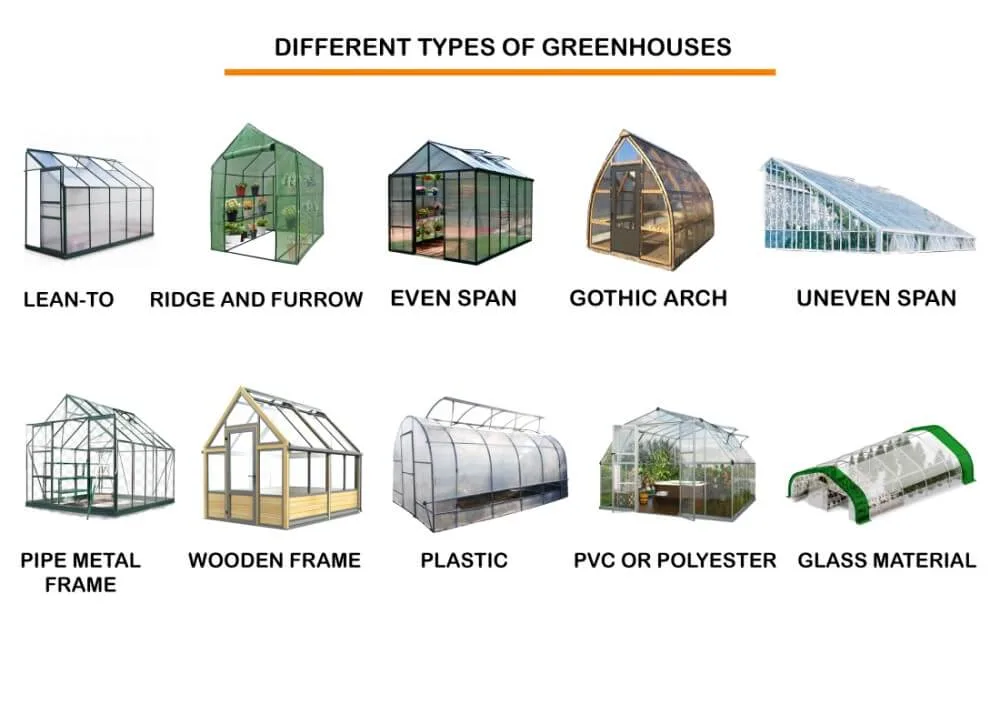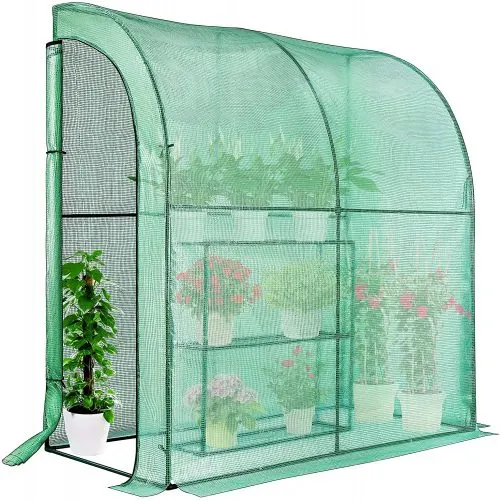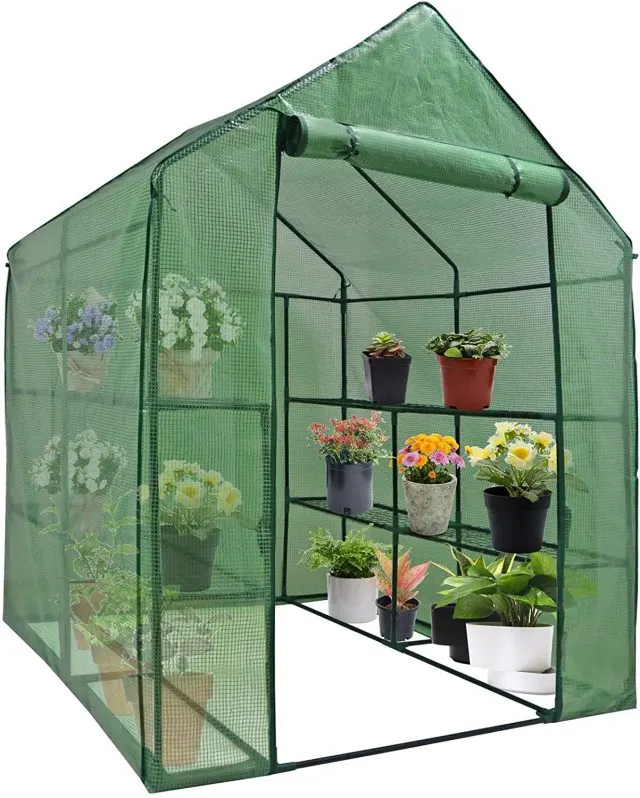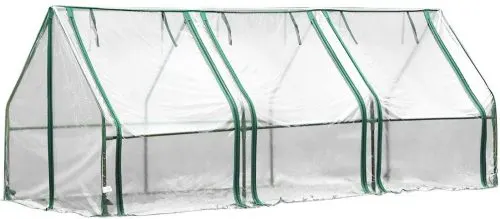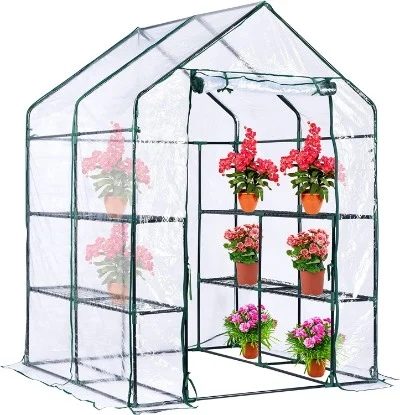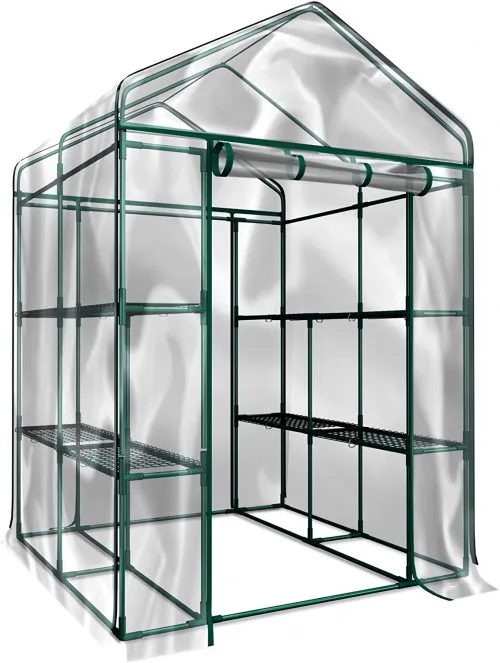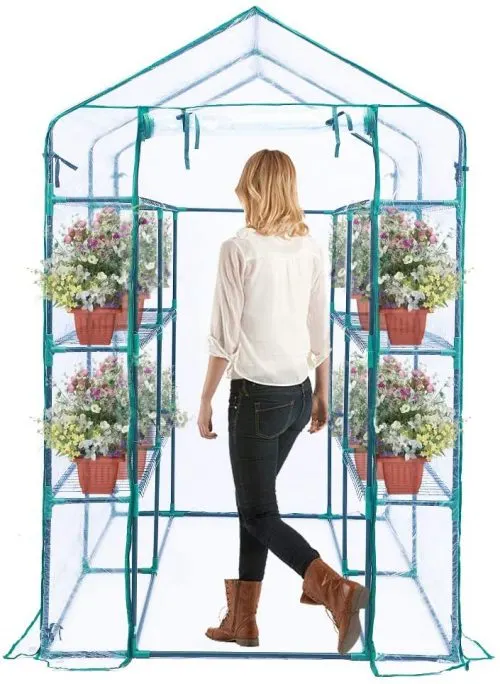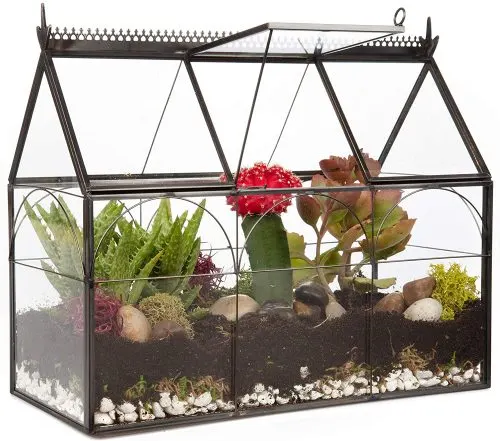Currently, there are over 1.2 million acres of land globally occupied by different types of greenhouses. Today we explore these greenhouse structures, identifying each class, including features that make them different.
If you’re interested in gardening or growing your food, you may have considered building a greenhouse. Greenhouses provide an ideal environment for plants, protecting them from Extreme weather conditions and pests.
Many different types of greenhouses are available on the market, so it’s essential to do your research before making a purchase. In this article, we’ll discuss the different types of greenhouses, their benefits, and critical features to look for when shopping.
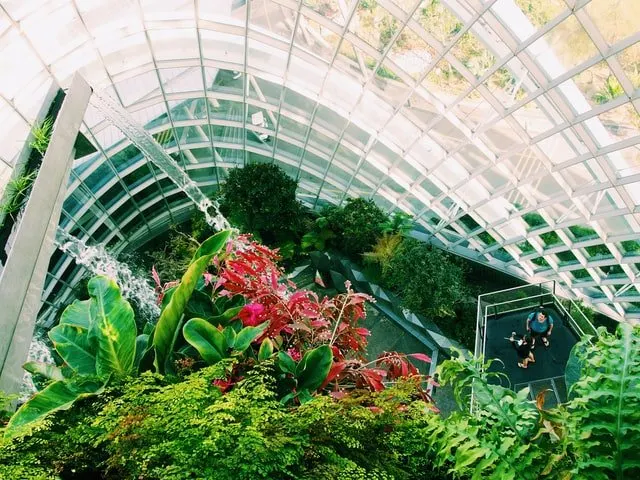
Types of Greenhouses to Buy Today
One primary way to classify a greenhouse is by looking at its structural shape or style. Each structure has pros and cons that are worth considering before making a purchase.
You can also categorize different types of greenhouses based on the frame material and outer covering material. Here are the various categories of greenhouses available in the market.
Greenhouse Categorization Based on Structural Shape/Style
There are different types of greenhouses, and one way to categorize them is through their structural shape. Under this category, you get:
1. Lean-To Greenhouse
When you place a greenhouse against a side of a building or attached to one side of an existing structure, it falls under this classification. You can use the greenhouse walls as one side of the greenhouse or place them between two buildings. Lean-to greenhouses leave you with three or two sides to cover with greenhouse sheeting material, plus the roof for a full enclosure.
Most Lean-to types of greenhouses or window-mounted greenhouses don’t exceed 12ft and can only carry 1 or 2 rows of plants at a time. However, you can extend it against an even longer wall while ensuring it gets ample sunlight.
Pros
- Near to amenities like electricity and water from the main building.
- Smaller structures incur less cost on materials.
- Requires a small space to set up.
- Fewer support requirements for the roof.
Cons
- It provides limited space for plants.
- It doesn’t have enough light exposure for proper plant growth.
- Hard to control the temperature because of the wall sides.
- Height limitation due to the supporting wall.
2. Ridge and Furrow Greenhouse
Another perfect example of a structural greenhouse type is the ridge and furrow that resembles an A-frame structure. The design involves connecting the A-frame greenhouse structures in a neat row. Each row relates to the eave, where all the excess snow and rain drains off.
Steel-blue roof shingles and white or dark wood paneling give this A-frame structure a classic country look. It’s inexpensive to make and can be constructed with only basic materials. This greenhouse may be built with very little use of wood or plastic film coverings in your home.
It also requires little construction knowledge. Because of the broad base and short height, the peaks may be more challenging to maneuver, and the heights are low. Airflows aren’t always ideal around the lower edges or tight angles.
This particular design is popular in a large farm setting where you have numerous greenhouses and don’t want any damage from rain or snow. The connection of several greenhouses acts to add more growing area, as well as increase the area for more sunlight penetration.
Also, this helps save on cost and energy to care for plants from one greenhouse to the next.
Pros
- It leaves enough room inside the structure to grow plants.
- Saves on automation and energy.
- Ensures structure longevity by draining rain and snow from the roof.
- An appealing look.
Cons
- Expensive to set up.
- Requires a big piece of land.
See Related: Best Insulation for a Greenhouse
Examples of Ridge and Furrow Greenhouse
You notice this greenhouse’s distinct A-frame greenhouse structure that you can set up as a ridge and farrow. All you need is to place the sides of the greenhouse together and open the ends to create one large room. The frame structure uses top-quality aluminum that’s not only durable but resistant to corrosion.
Additionally, the A-frame roof structure ensures their sample heat distribution to help all plants grow. Also, the greenhouse has eight plant shelves, and you can set it up in under 5 hours following the guide provided.
See Related: Best Greenhouse Paint & Spray-On Shading
3. Even Span Greenhouse
These types of greenhouses are easily identifiable by their two distinct sloping roofs. Depending on your measurements, you can comfortably use this design to set up a small greenhouse in your backyard.
As you set it up, you can consider attaching one end to the house or letting it stand on its own in the garden. You can also make it as big as possible to fit more rows and shelves that carry plenty of plants. All areas have transparent glass or other material, helping plants get ample sunlight.
However, heating such a wide area can cost more. You might need to set up a heating system to keep temperatures from plummeting during cold days and nights.
Pros
- Flexible design that won’t limit you in terms of size.
- Spacious for carrying many plants.
- An ideal shape that maintains uniformity in terms of temperature.
- A-frame roof that ensures rain/snow doesn’t accumulate.
Cons
- Expensive to set up.
- Requires own heating system.
4. Gothic Arch Greenhouses
Picture any gothic structure you’ve seen, and you’ll get a clear image of a gothic arch greenhouse. It has that distinctly pointed roof that helps eliminate the need to include trusses on the greenhouse structure. Such a structure is ideal for hobby and commercial use since it can be as small or as big as you want.
All you need is to note your space and expenses to decide on the size you want. Also, consider the Gothic arch greenhouse’s pros and cons before choosing.
Pros
- Versatile in that it can be a big or small structure.
- Appealing to look at.
- It makes it easy for snow and rain to drain off.
- It doesn’t require trusses.
Cons
- It takes up more materials when compared to other types of greenhouses.
- It doesn’t facilitate ample air circulation to the corners.
5. Uneven Span Greenhouse
You’ll notice a distinctive feature regarding the uneven-span greenhouse. One roof of this structure is longer than the other, hence the name. The primary reason for this structure’s design is to allow more sunlight intake when the greenhouse structure is in a hilly area.
Usually, the longer side of the roof faces the south and must be transparent. Given that most greenhouses are now in flat areas, this type of greenhouse isn’t as common.
Pros
- It helps sunlight reach the plants.
- Keeps the wind at bay.
- Sturdy and long-lasting structure.
Cons
- Not ideal for flat areas.
See Related: How to Utilize Greenhouse Bees for Pollination
Greenhouse Categorization Based on Frame Material
Every greenhouse requires a sturdy frame structure to give you optimal service. Without suitable materials, the frame gets weak with time and can easily fall over. So in this categorization, you have a chance to learn the best materials to use on different types of greenhouses.
6. Pipe Metal Frame Greenhouses
Many pipe-framed greenhouse structures use heavy-duty metals like steel and aluminum. These metals are long-lasting so you can use the greenhouse for a long time.
Once you opt for the metal pipe frame structure, ensure you know what metal is used since some are prone to corrosion. Also, it’s wise to use durable metal if the greenhouse is for commercial purposes, reducing the cost of replacing worn-out pipes.
Pros
- Uses durable metal material.
- It provides a sturdy structure that can withstand the elements.
- Even in high temperatures, metal frame structures are resistant to heat.
Cons
- Heavy-duty metal is expensive.
Examples of Pipe Metal Frame Greenhouses
This type of greenhouse structure has pipes made using heavy-duty steel alloy covering material. Not only is it sturdy, but it also prevents corrosion from making the design weak.
It also has a top-quality PVC covering those guards against harmful UV while creating a conducive environment for growing plants. In addition, it requires just a short time to set it up and move in your plants. Also, the mini greenhouse is suitable for indoor and outdoor use.
With six shelves and three tiers, you have another excellent quality greenhouse to set up inside or outside the house. The frame is made using alloy steel, is durable, and won’t bend under the plant’s weight.
Still, the structure is easy to move from place to place and provides ample shelf space for potted plants.
See Related: Best Greenhouses to Buy – Reviews & Buying Guide.
7. Wooden Frame Greenhouses
Most cold climate weather greenhouses include wooden frame structures that help preserve the heat inside. Most of these are small setups in the backyard to store plants until springtime. Wood is readily available in many places and easy to work with, even without hiring a professional to set up the greenhouse.
Pros
- Thermal efficiency helps the greenhouse remain warm during cold winter months.
- Easy to build and make repairs.
- Wood is naturally attractive, especially when you have exposed grain.
- The timber frame is more environmentally friendly.
Cons
- Wood is expensive when not locally sourced.
- If not properly treated, it’s prone to insect attacks.
8. Plastic Greenhouses
Tough plastic can make a quality greenhouse, especially one to keep indoors away from direct wind. As you seek different types of cheap greenhouses, you might want to consider those made using plastic frames. Since the material is inexpensive, you won’t have to go out of budget when setting one up.
Pros
- Plastic greenhouses are affordable.
- Quality plastic creates a sturdy frame.
- They aren’t prone to damage like wood greenhouses.
- They’re easy to clean.
Cons
- Plastic frames aren’t ideal for large structures.
See Related: How to Winterize a Greenhouse [Step-by-Step Guide]
Bonus: Based on the Greenhouse Structure
- Hoop House
A hoop house is a type of greenhouse made up of a simple, curved roof. The roof comprises PVC or metal hoops, which are covered in plastic or fabric. The plastic or fabric traps the heat and sunlight and helps to keep the inside of the greenhouse warm. A hoop house is often used to grow vegetables.
- Sawtooth
The sawtooth greenhouse is one of the more popular types of greenhouse. It gets its name from the unique roofline, which features a series of triangular peaks. This design allows a lot of natural light to come in, making it an ideal choice for growers who want to maximize their production.
- Shade House
It is a type of greenhouse designed to grow plants in the shade. These greenhouse types are typically made out of lighter construction materials like plastic or cloth, allowing sunlight to filter through. Shade houses can be used to grow various plants, including vegetables, fruits, and flowers.
- Geodesic Dome
The geodesic dome greenhouse is a type of greenhouse made up of a series of interconnected triangle-shaped panels. This type of greenhouse is often used for large-scale commercial farming, as it can provide much space for plants to grow.
- Freestanding
A freestanding greenhouse is a structure that is not attached to any other building. This type of greenhouse is often used in colder climates as it can provide insulation from the elements. Freestanding greenhouse can be made from various materials, including metal, wood, and plastic.
Greenhouse Categorization Based on Material Coverage
Various materials are used to cover different types of greenhouses. It determines what types of greenhouses are used in specific locations. And depending on your site, here are some materials to choose from.
9. PVC or Polyester Plastic Greenhouse Material
One of the most popular materials to cover a greenhouse is PVC plastic. It’s transparent and essential to allow sunlight to reach the plants. Also, it saves you money in terms of the cost and heating of the greenhouse.
Pros
- Readily available.
- Allows ample sunlight penetration.
- It was cheap.
- It’s lightweight and easy to set up.
Cons
- Prone to damage after some time.
Example of PVC Greenhouse
This walk-in greenhouse uses quality PVC material that facilitates ample light penetration. You can place it indoors or outdoors. The frame structure is heavy-duty steel material that ensures it’s sturdy and durable.
You get eight shelves to store plants inside, and you won’t need any tools when setting it up.
The long and wide structure allows you to walk in and tend to the plants. It’s covered using top-quality PVC to protect plants against harmful UV rays while permitting good light penetration.
Additionally, the outer frame uses heavy-duty metal that remains strong even when all three tiers are full of potted plants.
10. Glass Material Greenhouses
Glass is another quality material used to cover different types of greenhouses. It facilitates deeper light intensity, which is ideal for healthy plants. Also, it allows ample air filtration, which best controls the humid environment.
Pros
- Allows more light penetration.
- Facilitates ample air filtration.
- Appealing to look at.
Cons
- Glass is expensive to use, especially in a huge greenhouse.
Example of Glass Greenhouses
You can easily set up this glass mini greenhouse indoors and plant some succulents. It provides the perfect humidity to help plants grow. Glass is also the best material for light penetration, thus ideal for plants needing lots of light.
See Related: How to Install a Greenhouse [Step-by-Step Guideline]
What is a Greenhouse?
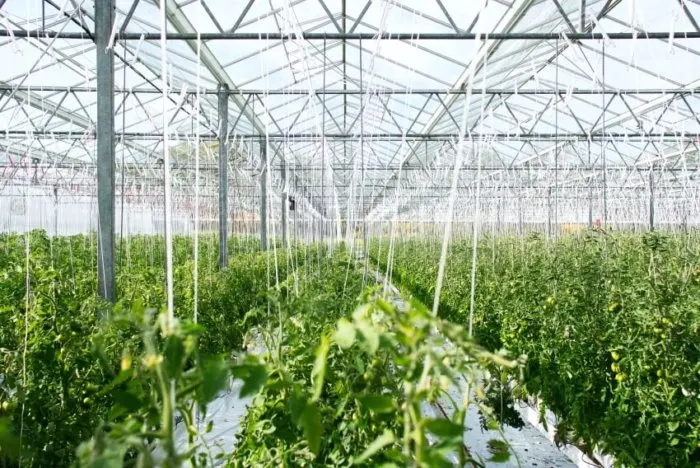
A greenhouse is a structure that comes in handy when you want to grow plants in a controlled environment. This environment enables faster and healthy growth of plants no matter the season.
As you contemplate getting one, it’s worth noting that different greenhouses are ideal for various purposes, plants, and situations.
For this reason, the type of greenhouse you choose will primarily depend on your specific needs. And some will work better in some situations than others.
See Related: How to Build a Hydroponic Greenhouse
Benefits of Having a Greenhouse
There are many benefits to having a greenhouse, regardless of the type you choose. Greenhouses provide a controlled environment that is ideal for plants.
By protecting plants from extreme weather conditions, greenhouses help to extend the growing season and allow for year-round gardening. Additionally, greenhouses can protect plants from pests, allowing you to grow organic produce without the use of harmful chemicals.
What Type of Greenhouse is Ideal in What Location?

How can you choose the best site for a greenhouse? Is the greenhouse you have in mind the best for that location? Answering these vital questions helps you make the best selection in terms of location.
By following the tips listed below, you can determine the best types of greenhouses for various locations.
Sunlight Intensity
Some greenhouses suit areas with less sunlight, while others require intense solar radiation to facilitate plant growth. The best types of greenhouses in this situation depend on the location you choose for each. For example, you can opt for an uneven-span greenhouse if you’re in a hilly location.
Land Size
How much land can you spare for a greenhouse? You can try mini greenhouse or lean-to design structures if you have a small piece of land. Larger areas are suitable for more big structures like Gothic Arch or Ridge and Furrow.
Weather Conditions
While you can set up a greenhouse anywhere, it’s the weather conditions should be kept in mind. Areas prone to months of snow are suitable for wood greenhouses that help retain warmth for the plants.
On the other hand, those extremely windy areas need heavy-duty metal frames to keep greenhouses firmly arched to the ground.
Ground Stability
Not all surfaces are stable. Those with less stability require more heavy-duty structures like metal and thick wood. In areas with more strength, you can build plastic greenhouses without worry. Also, you must choose a location where water drains off quickly.
What Features Should You Look for When Choosing a Greenhouse?
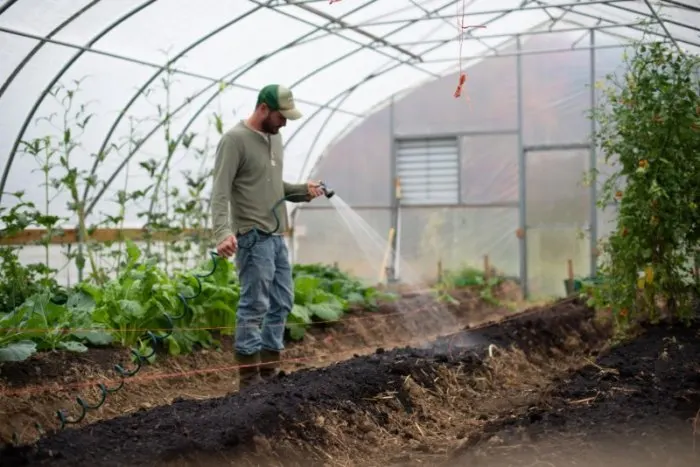
There are many factors to consider when choosing a greenhouse. The most important things to look for are the size, type of material, and type of ventilation.
Size is important because you must ensure the greenhouse is big enough to accommodate all of your plants. You should also consider the amount of space you have available. If you have a small yard, you might want to choose a smaller greenhouse or an attached greenhouse.
The type of material is essential because it will affect the durability and price of the greenhouse. Wooden greenhouses are the most traditional, but they’re also the most expensive. Metal and plastic greenhouses are more affordable, but they’re not as durable.
The type of ventilation is essential because it will affect the temperature inside the greenhouse. Greenhouses can get very hot in the summer, so it’s choosing a greenhouse with good ventilation is essential. Hoop greenhouses and gable greenhouses are two types of greenhouses that have excellent natural ventilation.
Now that you know the different types of greenhouses and what features to look for, you’re ready to choose the perfect one for your needs!
FAQ
What is the best type of greenhouse for a small garden?
The best greenhouses for small gardens are mini-greenhouses or lean-to design structures. These greenhouses are perfect for smaller spaces and can be easily moved if necessary.
What is the best type of greenhouse for a windy location?
The best greenhouses for windy locations are those with heavy-duty metal frames to keep them firmly arched to the ground.
It will ensure that the structure does not blow over in strong winds. Greenhouses with plastic panels are also a good option as they are less likely to be damaged by high winds.
How can I choose the best site for a greenhouse?
The best site for a greenhouse depends on its purpose. A hobby greenhouse can go almost anywhere, but if you’re growing vegetables or flowers for sale, you’ll need to find a spot with plenty of sunlight and a bigger space.
What are the 3 main types of greenhouse?
There are three main types of greenhouse: freestanding, attached, and hoop house. Freestanding greenhouses are standalone structures that can be placed anywhere on a property. Attached greenhouses are built onto an existing structure, such as a home or garage. Hoop houses are temporary structures made from PVC pipes or metal hoops covered in plastic or fabric. Each type of greenhouse has its own advantages and disadvantages, depending on factors such as climate, location, and intended use.

